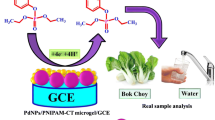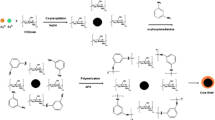Abstract
A novel platform for carbamate-based pesticide quantification using a chitosan/magnetic iron oxide (Chit-Fe3O4) nanocomposite as a glassy carbon electrode (GCE) modifier is shown for an analytical methodology for determination of bendiocarb (BND). The BND oxidation signal using GCE/Chit-Fe3O4 compared with bare GCE was catalyzed, showing a 37.5% of current increase with the peak potential towards less positive values, showing method’s increased sensitivity and selectivity. Using square-wave voltammetry (SWV), calibration curves for BND determination were obtained (n = 3), and calculated detection and quantification limits values were 2.09 × 10−6 mol L−1 (466.99 ppb) and 6.97 × 10−6 mol L−1 (1555.91 ppb), respectively. The proposed electroanalytical methodology was successfully applied for BND quantification in natural raw waters without any sample pretreatment, proving that the GCE/Chit-Fe3O4 modified electrode showed great potential for BND determination in complex samples.

ᅟ
Graphical abstract







Similar content being viewed by others
References
Kuhr RJ, Dorough HW. Carbamate insecticides: chemistry, biochemistry, and toxicology. CRC Press, Inc.; 1976.
Kamrin MA. Pesticide profiles: toxicity, environmental impact, and fate. CRC Press; 1997.
Wang QQ, Lemley AT. Competitive degradation and detoxification of carbamate insecticides by membrane anodic Fenton treatment. J Agric Food Chem. 2003;51:5382–90.
Szeto SY, Wilkinson ATS, Brown MJ. A gas-chromatographic method for the determination of bendiocarb in soil and corn—application to the analysis of residues in corn. J Agric Food Chem. 1984;32:78–80.
Climent MJ, Miranda MA. Gas chromatographic-mass spectrometric study of photodegradation of carbamate pesticides. J Chromatogr A. 1996;738:225–31.
O. Wuest, W. Meier, Determination of seven carbamate insecticides on fruits and vegetables by capillary gas-chromatography and afid, Zeitschrift Fur Lebensmittel-Untersuchung Und-Forschung, 177 (1983) 25–29.
Menezes ML, Felix G. On line extraction and separation of bendiocarb, methomyl, methylparathion, and pentachlorophenol pesticides from raw milk. J Liq Chromatogr Relat Technol. 1998;21:2863–71.
Zehner JM, Simonaitis RA, Bry RE. High-performance liquid-chromatographic determination of bendiocarb on wool. J Assoc Off Anal Chem. 1980;63:47–8.
Perez-Ruiz T, Martinez-Lozano C, Garcia MD. Determination of N-methylcarbamate pesticides in environmental samples by an automated solid-phase extraction and liquid chromatographic method based on post-column photolysis and chemiluminescence detection. J Chromatogr A. 2007;1164:174–80.
Handa SK. Spectrophotometric method for the microdetermination of bendiocarb standard residues in water. J Assoc Off Anal Chem. 1988;71:51–2.
Pacioni NL, Veglia AV. Determination of poorly fluorescent carbamate pesticides in water, bendiocarb and promecarb, using cyclodextrin nanocavities and related media. Anal Chim Acta. 2007;583:63–71.
Scholz F. Electroanalytical methods: guide to experiments and applications. Berlin: Springer; 2009.
Uslu B, Ozkan SA. Electroanalytical methods for the determination of pharmaceuticals: a review of recent trends and developments. Anal Lett. 2011;44:2644–702.
Hitchman ML, Ramanathan S. The determination of a carbamate insecticide in soil samples by differential pulse polarography. Anal Chim Acta. 1984;157:349–54.
Guiberteau A, Duran-Meras I, Galeano T, Laranjinho TJF, Mora NM, Suarez MF, et al. Voltammetric study of the hydrolysis product of bendiocarb at the glassy carbon electrode. Mikrochim Acta. 2001;137:135–40.
Rao TN, Loo BH, Sarada BV, Terashima C, Fujishima A. Electrochemical detection of carbamate pesticides at conductive diamond electrodes. Anal Chem. 2002;74:1578–83.
Mirceski V, Komorsky-Lovric S, Lovric M. Square-wave voltammetry: theory and application. Berlin: Springer Science & Business Media; 2007.
Luo X, Morrin A, Killard AJ, Smyth MR. Application of nanoparticles in electrochemical sensors and biosensors. Electroanalysis. 2006;18:319–26.
Haun JB, Yoon TJ, Lee H, Weissleder R. Magnetic nanoparticle biosensors. Wiley Interdiscip Rev Nanomed Nanobiotechnol. 2010;2:291–304.
Luan F, Zhang S, Chen D, Zheng K, Zhuang X. CoS2-decorated ionic liquid-functionalized graphene as a novel hydrazine electrochemical sensor. Talanta. 2018;182:529–35.
Zhuang X, Tian C, Luan F, Wu X, Chen L. One-step electrochemical fabrication of a nickel oxide nanoparticle/polyaniline nanowire/graphene oxide hybrid on a glassy carbon electrode for use as a non-enzymatic glucose biosensor. RSC Adv. 2016;6:92541–6.
Zhuang X, Wang H, He T, Chen L. Enhanced voltammetric determination of dopamine using a glassy carbon electrode modified with ionic liquid-functionalized graphene and carbon dots. Microchim Acta. 2016;183:3177–82.
Zhuang X, Chen D, Wang S, Liu H, Chen L. Manganese dioxide nanosheet-decorated ionic liquid-functionalized graphene for electrochemical theophylline biosensing. Sensors Actuators B Chem. 2017;251:185–91.
Chen D, Zhuang X, Zhai J, Zheng Y, Lu H, Chen L. Preparation of highly sensitive Pt nanoparticles-carbon quantum dots/ionic liquid functionalized graphene oxide nanocomposites and application for H2O2 detection. Sensors Actuators B Chem. 2018;255:1500–6.
Zhuang X, Chen D, Zhang S, Luan F, Chen L. Reduced graphene oxide functionalized with a CoS2/ionic liquid composite and decorated with gold nanoparticles for voltammetric sensing of dopamine. Microchim Acta. 2018;185:166.
Zhou N, Li J, Chen H, Liao C, Chen L. A functional graphene oxide-ionic liquid composites–gold nanoparticle sensing platform for ultrasensitive electrochemical detection of Hg2+. Analyst. 2013;138:1091–7.
Roushani M, Bakyas K, Zare Dizajdizi B. Development of sensitive amperometric hydrogen peroxide sensor using a CuNPs/MB/MWCNT-C60-Cs-IL nanocomposite modified glassy carbon electrode. Mater Sci Eng C. 2016;64:54–60.
Roushani M, Valipour A. Voltammetric immunosensor for human chorionic gonadotropin using a glassy carbon electrode modified with silver nanoparticles and a nanocomposite composed of graphene, chitosan and ionic liquid, and using riboflavin as a redox probe. Microchim Acta. 2016;183:845–53.
Roushani M, Valipour A. Using electrochemical oxidation of Rutin in modeling a novel and sensitive immunosensor based on Pt nanoparticle and graphene–ionic liquid–chitosan nanocomposite to detect human chorionic gonadotropin. Sensors Actuators B Chem. 2016;222:1103–11.
Roushani M, Shahdost-fard F. A highly selective and sensitive cocaine aptasensor based on covalent attachment of the aptamer-functionalized AuNPs onto nanocomposite as the support platform. Anal Chim Acta. 2015;853:214–21.
Gupta AK, Gupta M. Synthesis and surface engineering of iron oxide nanoparticles for biomedical applications. Biomaterials. 2005;26:3995–4021.
Lu AH, Salabas EL, Schuth F. Magnetic nanoparticles: synthesis, protection, functionalization, and application. Angew Chem Int Ed. 2007;46:1222–44.
Shi X, Gu W, Li B, Chen N, Zhao K, Xian Y. Enzymatic biosensors based on the use of metal oxide nanoparticles. Microchim Acta. 2014;181:1–22.
Wu W, He Q, Jiang C. Magnetic iron oxide nanoparticles: synthesis and surface functionalization strategies. Nanoscale Res Lett. 2008;3:397–415.
Lin Z, Zhang Z, Li Y, Deng Y. Magnetic nano-Fe3O4 stabilized Pickering emulsion liquid membrane for selective extraction and separation. Chem Eng J. 2016;288:305–11.
Yang Z, Shi X, Dai M, Wang L, Xu X, Guo R. Co-metabolic removal of ciprofloxacin under condition of interaction between microbes and Fe3O4. Chem Eng J. 2018;333:649–56.
Peng G, Zhang M, Deng S, Shan D, He Q, Yu G. Adsorption and catalytic oxidation of pharmaceuticals by nitrogen-doped reduced graphene oxide/Fe3O4 nanocomposite. Chem Eng J. 2018;341:361–70.
Koushkbaghi S, Zakialamdari A, Pishnamazi M, Ramandi HF, Aliabadi M, Irani M. Aminated-Fe3O4 nanoparticles filled chitosan/PVA/PES dual layers nanofibrous membrane for the removal of Cr (VI) and Pb (II) ions from aqueous solutions in adsorption and membrane processes. Chem Eng J. 2018;337:169–82.
Kodama RH. Magnetic nanoparticles. J Magn Magn Mater. 1999;200:359–72.
Kumar M, Muzzarelli RAA, Muzzarelli C, Sashiwa H, Domb AJ. Chitosan chemistry and pharmaceutical perspectives. Chem Rev. 2004;104:6017–84.
Yu C, Gou L, Zhou X, Bao N, Gu H. Chitosan–Fe3O4 nanocomposite based electrochemical sensors for the determination of bisphenol A. Electrochim Acta. 2011;56:9056–63.
Kaushik A, Solanki PR, Ansari AA, Sumana G, Ahmad S, Malhotra BD. Iron oxide-chitosan nanobiocomposite for urea sensor. Sensors Actuators B Chem. 2009;138:572–80.
Liu X, Zheng S, Hu Y, Li Z, Luo F, He Z. Electrochemical immunosensor based on the chitosan-magnetic nanoparticles for detection of tetracycline. Food Anal Methods. 2016;9:2972–8.
Wang Y-H, Yu C-M, Gu H-Y, Tu Y-F. The hemoglobin-modified electrode with chitosan/Fe3O4 nanocomposite for the detection of trichloroacetic acid. J Solid State Electrochem. 2016;20:1337–44.
Ran G, Chen X, Xia Y. Electrochemical detection of serotonin based on a poly (bromocresol green) film and Fe3O4 nanoparticles in a chitosan matrix. RSC Adv. 2017;7:1847–51.
Dehdashtian S, Gholivand MB, Shamsipur M, Kariminia S. Construction of a sensitive and selective sensor for morphine using chitosan coated Fe3O4 magnetic nanoparticle as a modifier. J Mater Chem A. 2016;58:53–9.
Freire TM, Dutra LMU, Queiroz DC, Ricardo NMPS, Barreto K, Denardin JC, et al. Fast ultrasound assisted synthesis of chitosan-based magnetite nanocomposites as a modified electrode sensor. Carbohydr Polym. 2016;151:760–9.
Oliveira TMBF, Ribeiro FWP, do Nascimento JM, Soares JES, Freire VN, Becker H, et al. Direct electrochemical analysis of dexamethasone endocrine disruptor in raw natural waters. J Braz Chem Soc. 2012;23:110–9.
Sousa CP, Salvador MA, Homem-de-Mello P, Ribeiro FWP, de Lima-Neto P, Correia AN. Computational modeling of functionalized multi-walled carbon nanotubes dispersed in polyethylenimine for electrochemical sensing of acetaminophen. Sensors Actuators B Chem. 2017;246:969–78.
Warner J, Engel T, Mondron P. Determination of bendiocarb in industrial and municipal wastewaters. Washington, D.C.: US Environ. Prot. Agency; 1985. EPA/600/4-85/021.
C. Analytical Methods. Recommendations for the definition, estimation and use of the detection limit. Analyst. 1987;112:199–204.
Mocak J, Bond A, Mitchell S, Scollary G. A statistical overview of standard (IUPAC and ACS) and new procedures for determining the limits of detection and quantification: application to voltammetric and stripping techniques (technical report). Pure Appl Chem. 1997;69:297–328.
Oliveira TMBF, Becker H, Longhinotti E, De Souza D, de Lima-Neto P, Correia AN. Carbon-fibre microelectrodes coupled with square-wave voltammetry for the direct analysis of dimethomorph fungicide in natural waters. Microchem J. 2013;109:84–92.
Bard AJ, Faulkner LR. Electrochemical methods: fundamentals and applications. Wiley; 2000.
Urbanova V, Magro M, Gedanken A, Baratella D, Vianello F, Zboril R. Nanocrystalline iron oxides, composites, and related materials as a platform for electrochemical, magnetic, and chemical biosensors. Chem Mater. 2014;26:6653–73.
Sharma G, Kumar D, Kumar A, Al-Muhtaseb AH, Pathinia D, Naushad M, et al. Revolution from monometallic to trimetallic nanoparticle composites, various synthesis methods and their applications: a review. J Mater Chem A. 2017;71:1216–30.
Sousa CP, de Oliveira RC, Freire TM, Fechine PBA, Salvador MA, Homem-de-Mello P, et al. Chlorhexidine digluconate on chitosan-magnetic iron oxide nanoparticles modified electrode: electroanalysis and mechanistic insights by computational simulations. Sensors Actuators B Chem. 2017;240:417–25.
Li X, Li Y, Li S, Zhou W, Chu H, Chen W, et al. Single crystalline trigonal selenium nanotubes and nanowires synthesized by sonochemical process. Cryst Growth Des. 2005;5:911–6.
Neto DMA, Freire RM, Gallo J, Freire TM, Queiroz DC, Ricardo NMPS, et al. Rapid sonochemical approach produces functionalized Fe3O4 nanoparticles with excellent magnetic, colloidal, and relaxivity properties for MRI application. J Phys Chem C. 2017;121:24206–22.
Singh AK, Srivastava ON, Singh K. Shape and size-dependent magnetic properties of Fe3O4 nanoparticles synthesized using piperidine. Nanoscale Res Lett. 2017;12:298.
Compton RG, Banks CE. Understanding voltammetry. World Scientific; 2007.
Croucher L, Jewess P, Roberts MC. Metabolic pathways of agrochemicals: part 2: insecticides and fungicides. Royal Society of Chemistry; 2007.
Skládal P. Determination of organophosphate and carbamate pesticides using a cobalt phthalocyanine-modified carbon paste electrode and a cholinesterase enzyme membrane. Anal Chim Acta. 1991;252:11–5.
Kumar KS, Suvardhan K, Rekha D, Kiran K, Jayaraj B, Janardhanam K, et al. Development of simple and sensitive spectrophotometric method for the determination of bendiocarb in its formulations and environmental samples. Environ Monit Assess. 2007;127:67–72.
Jarvie HP, Sharpley AN, Withers PJA, Scott JT, Haggard BE, Neal C. Phosphorus mitigation to control river eutrophication: murky waters, inconvenient truths, and “postnormal” science. J Environ Qual. 2013;42:295–304.
Petersen CR, Jovanovic NZ, Grenfell MC, Oberholster PJ, Cheng P. Responses of aquatic communities to physical and chemical parameters in agriculturally impacted coastal river systems. Hydrobiologia. 2018;813:157–75.
Acknowledgements
The authors gratefully acknowledge the funding provided by the following Brazilian agencies: CNPq-INCT (proc. 573925/2008-9 and 573548/2008-0), CAPES/Funcap (2133/2012/proc. 23038.007973/2012-90 and PNE-0112-00048.01.00/16), CNPq (proc. 400223/2014-7, 303596/2014-7, 302801/2014-6 and 408790/2016-4), PRONEM/FUNCAP/CNPq (PNE-0112-00048.01.00/16) and PRONEX/Funcap (proc. PR2-0101-00030.01.00/15). The Fundação para a Ciência e a Tecnologia (FCT) and the FEDER, under Programme PT2020 (Project UID/QUI/50006/2013) and the project Qualidade e Segurança Alimentar- uma abordagem (nano) tecnológica (NORTE-01-0145-FEDER-000011) are also acknowledged for the financial funding. R.M.F. and J.C.D. acknowledge the financial support by Fondecyt 3170240 and Basal Program for Centers of Excellence, Grant FB0807 CEDENNA, CONICYT. C.P.S. thanks CAPES-PNPD for her grant.
Author information
Authors and Affiliations
Corresponding author
Ethics declarations
Conflict of interest
The authors declare that they have no conflict of interest.
Rights and permissions
About this article
Cite this article
de Oliveira, R.C., Sousa, C.P., Freire, T.M. et al. Chitosan-magnetite nanocomposite as a sensing platform to bendiocarb determination. Anal Bioanal Chem 410, 7229–7238 (2018). https://doi.org/10.1007/s00216-018-1330-1
Received:
Revised:
Accepted:
Published:
Issue Date:
DOI: https://doi.org/10.1007/s00216-018-1330-1




